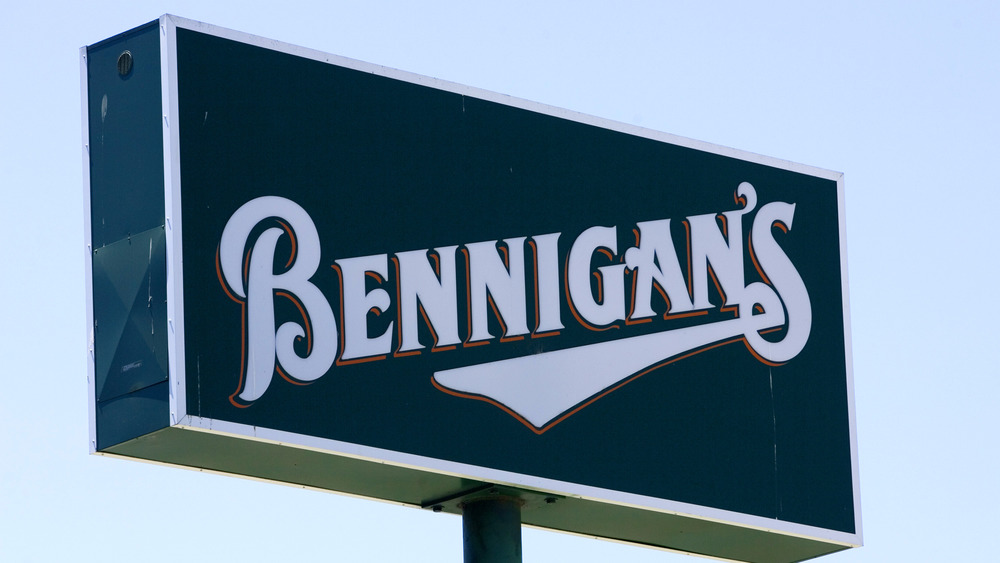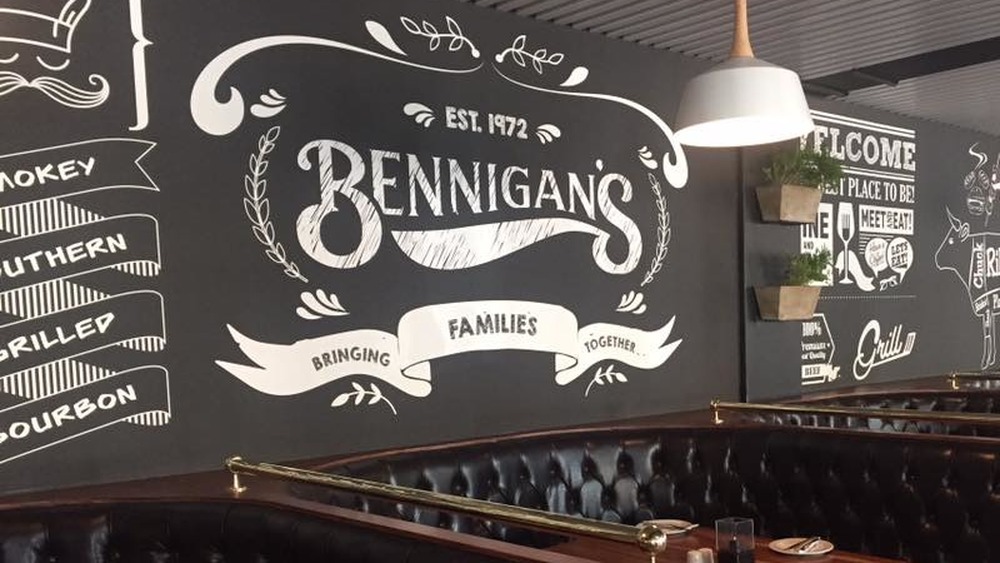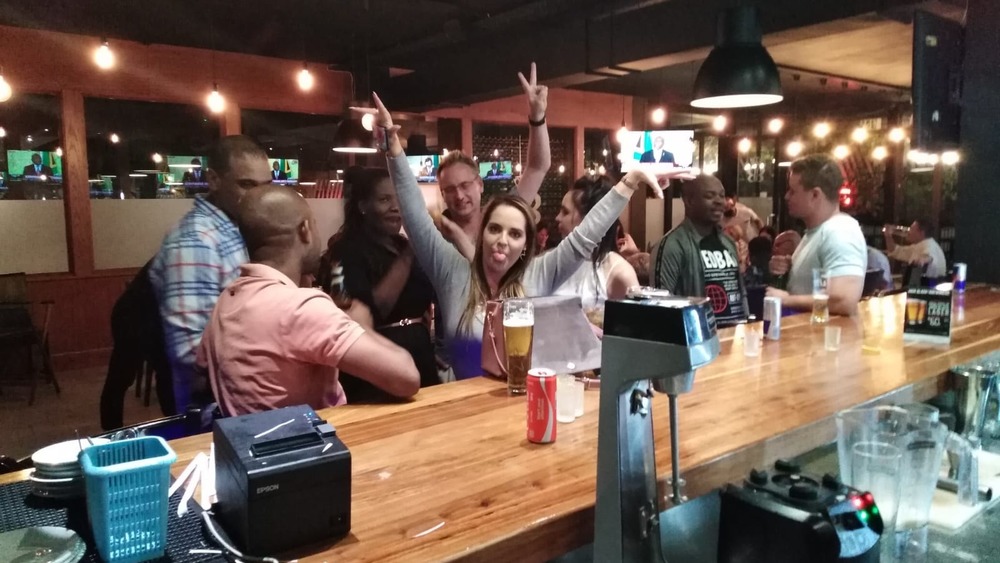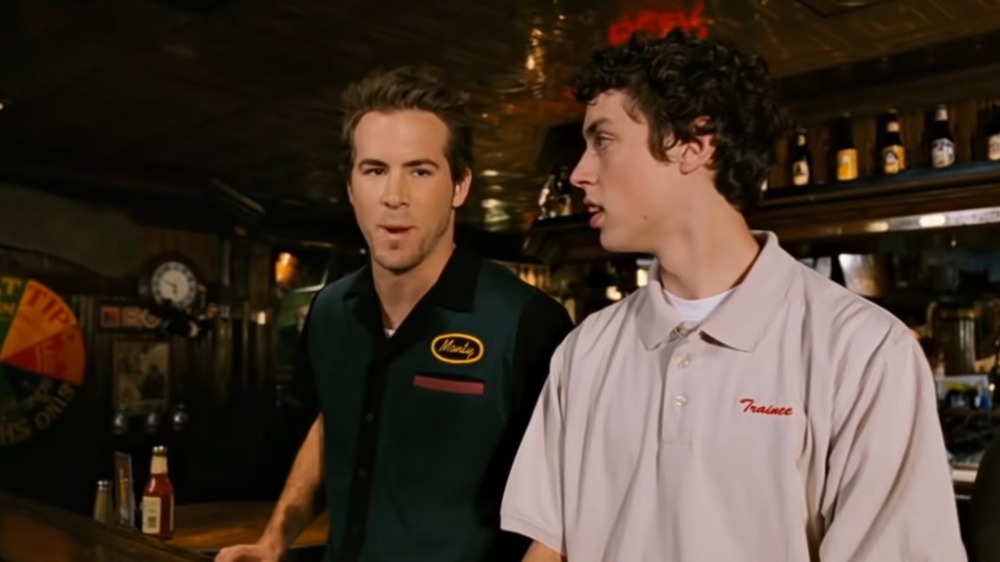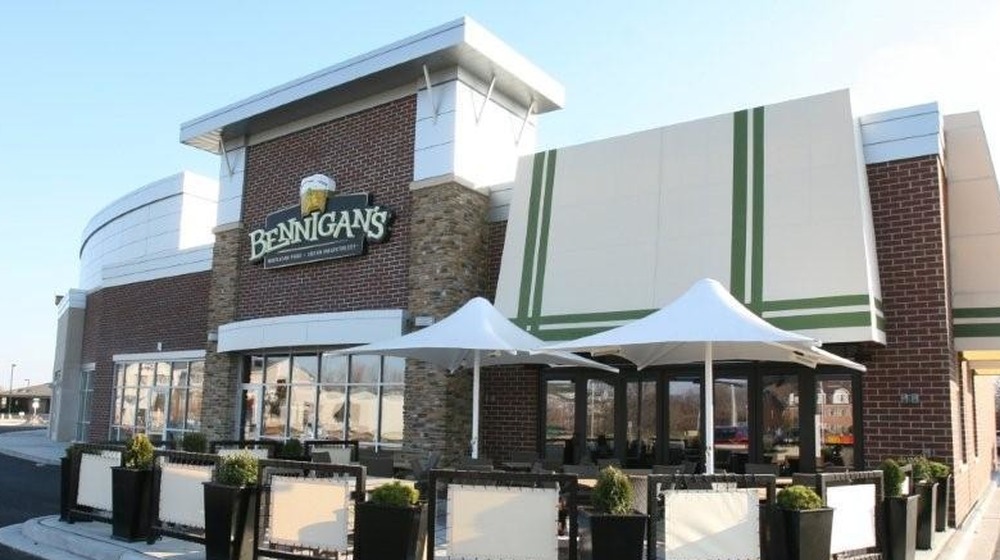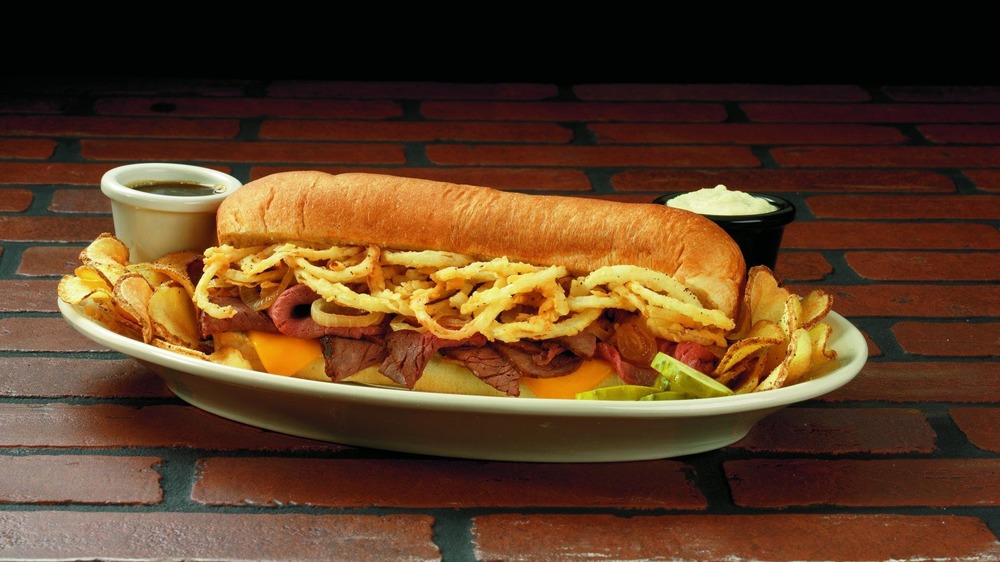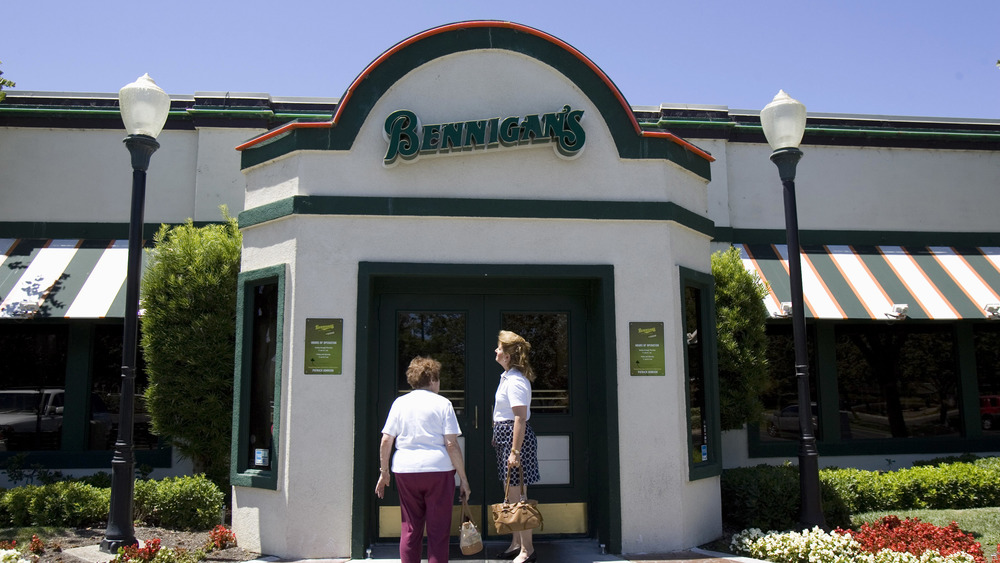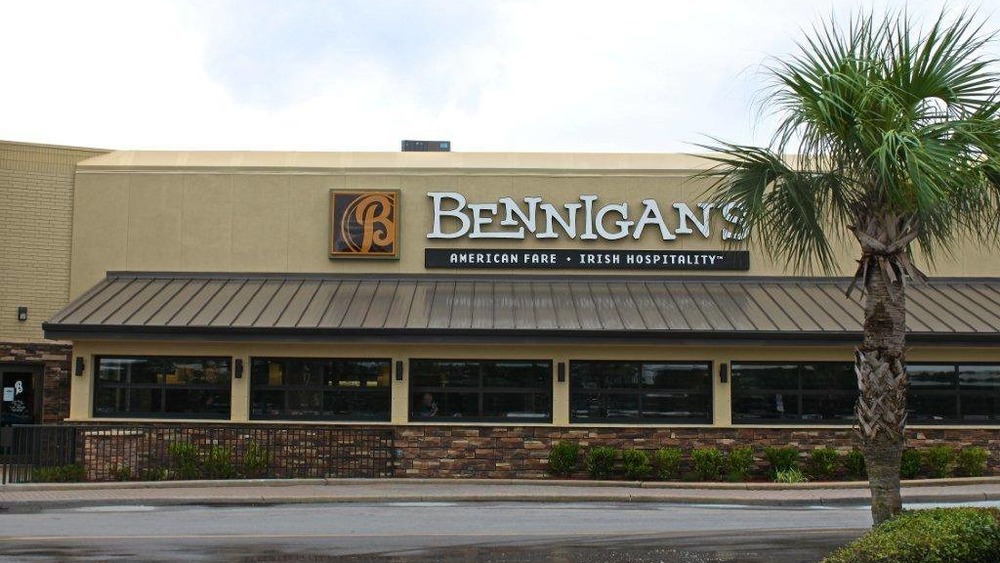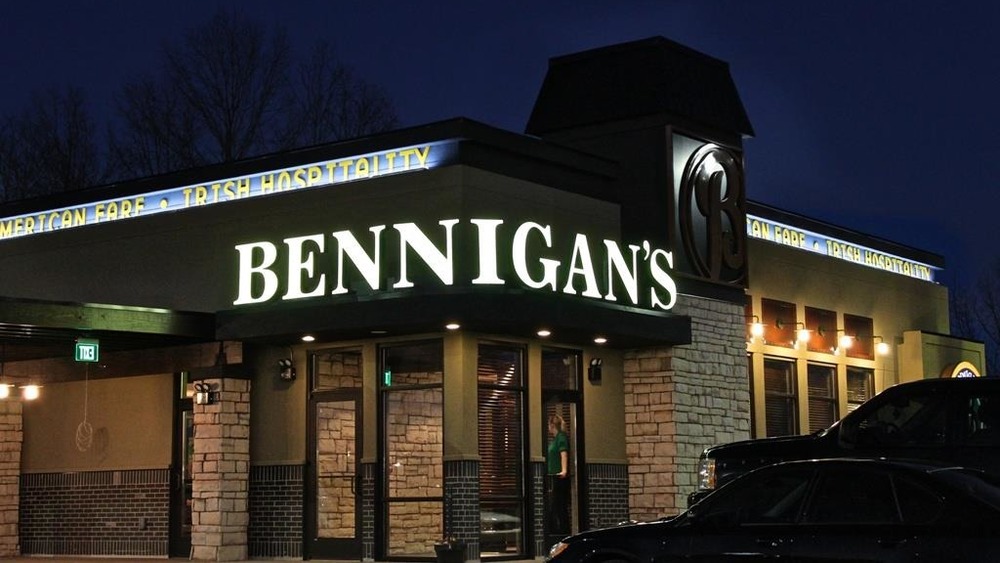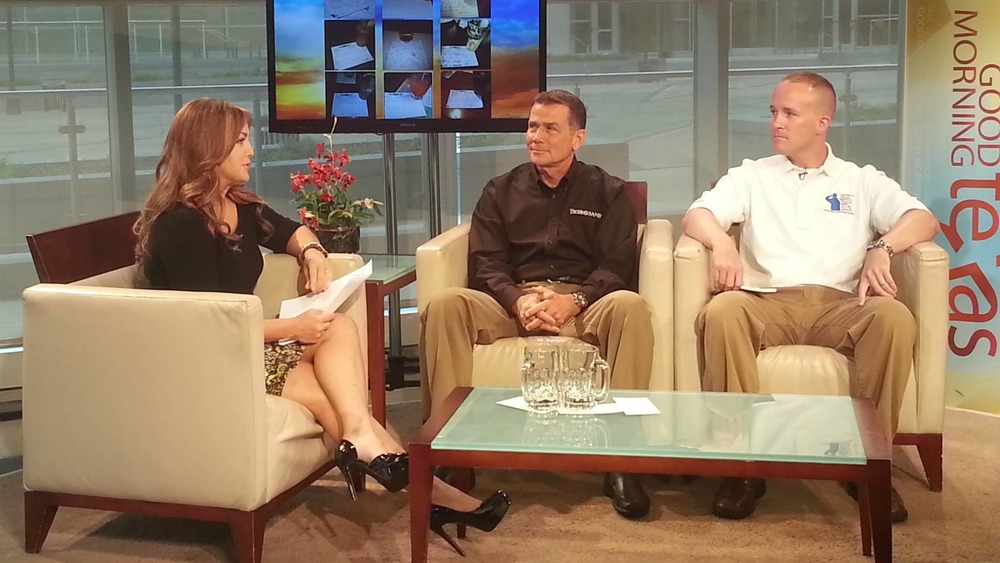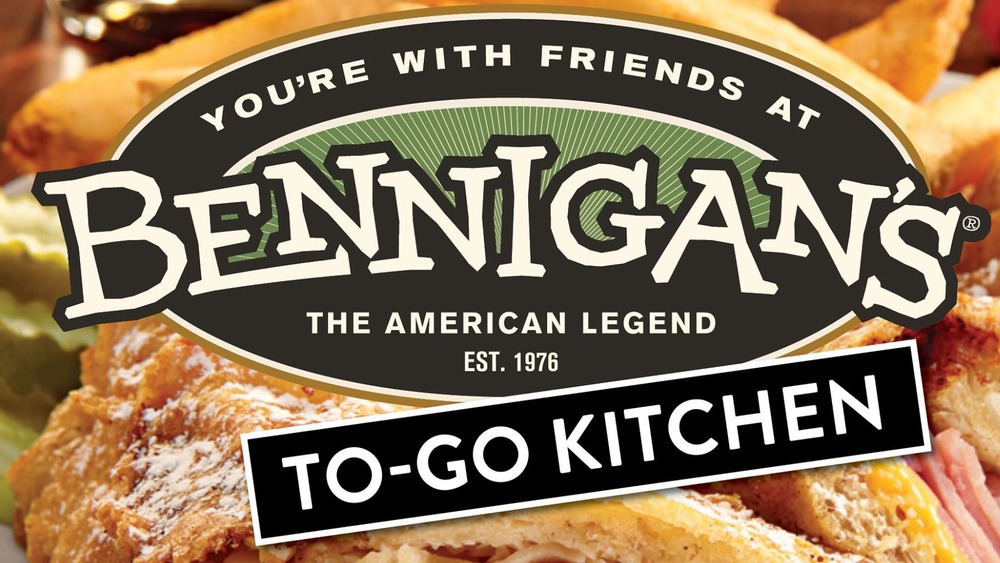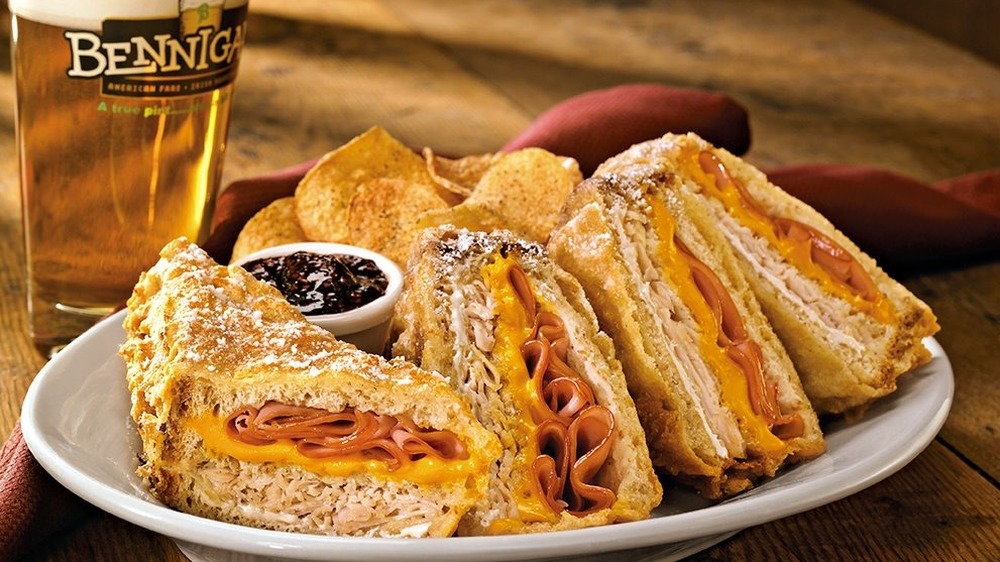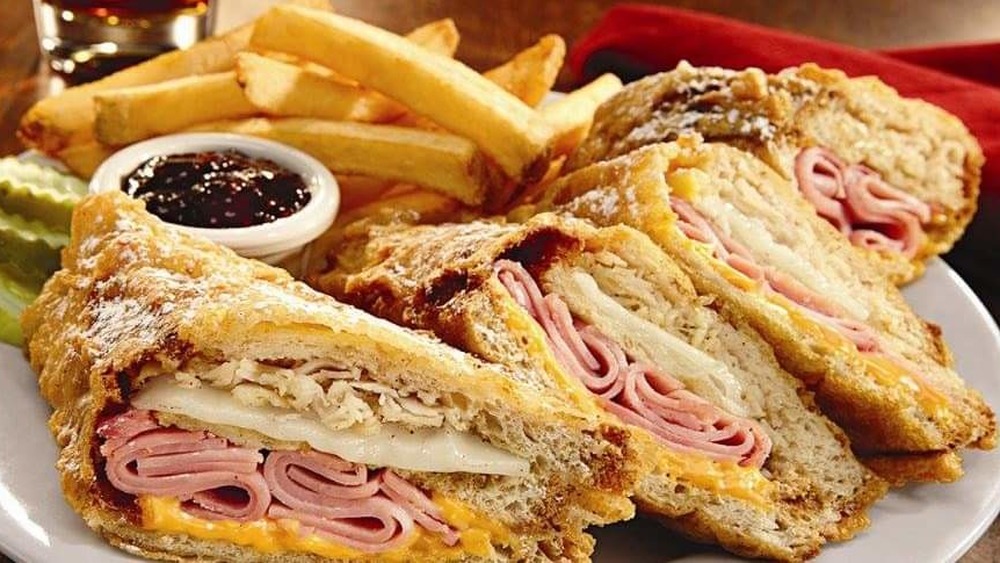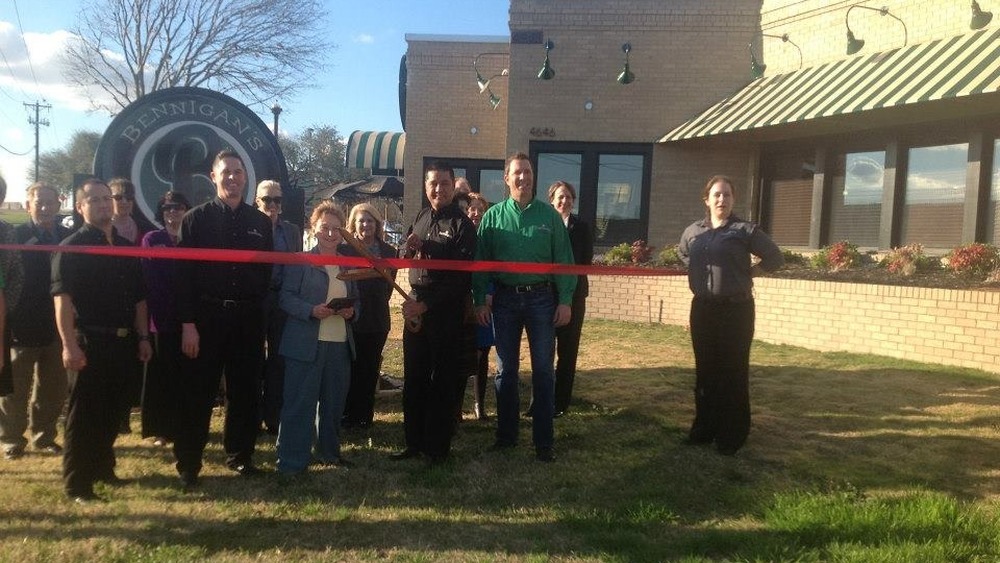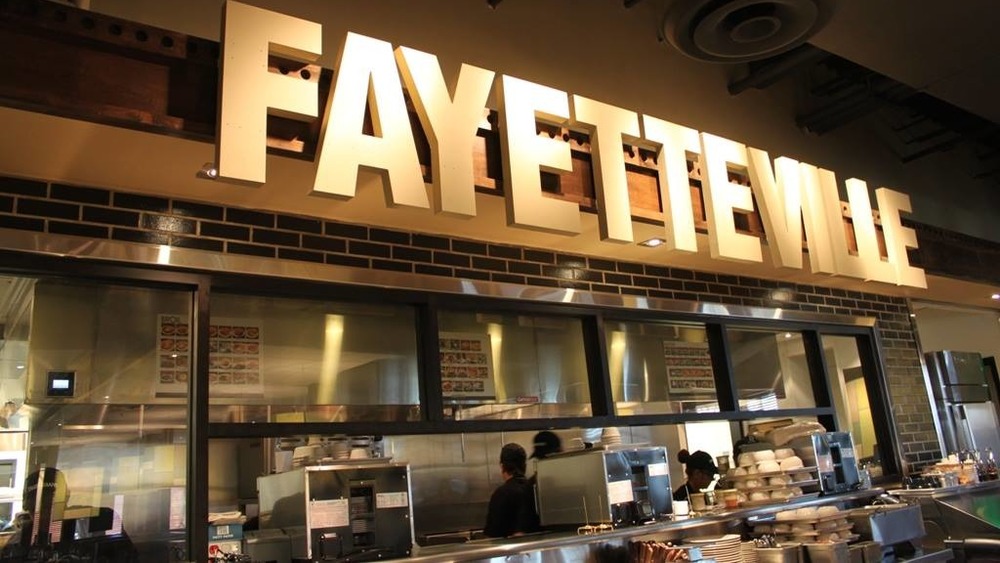The Untold Truth Of Bennigan's
Whatever happened to Bennigan's? It's a question that gets perpetually kicked around office happy hours, when people reminisce on the glory of drinking in a plant-filled bar that offered dependably decent food. But the spot that was once an after-work go to and Valentine's date for the unimaginative shocked the world in 2008, when its parent company announced bankruptcy and immediately closed 150 locations. The reasons for this are myriad, but the brand has been slow to recover.
But don't count Bennigan's out yet. Since being purchased by its CEO in 2015 Bennigan's has undergone a massive transformation, slicing its restaurant size, streamlining operations, and changed the places where it does business. And you might even find Bennigan's on the menu the next time you order room service. So come along as we look at Bennigan's journey from Pillsbury subsidiary to hotel room hot sandwiches, and where it goes from here.
Bennigan's was originally founded as part of the Pillsbury Corporation
Though the floral and wood décor and happy hour culture of Bennigan's feels as woven into American restaurant culture as Happy Meals and the Bloomin' Onion, the fact is the restaurant is barely over 40 years old. The original concept was founded by Dallas-area restaurateur Allen Brinker in 1976. At the same time he started Bennigan's, Brinker also founded Steak and Ale, another beloved comfort food happy hour spot that ultimately failed.
Interestingly, Brinker did not start Bennigan's as his own venture, but rather for the Pillsbury Corporation. And while it wasn't serving biscuits and cinnamon rolls, necessarily, Bennigan's did become known for serving big portions of not-so-healthy food later on. The first location also was not in Dallas, but rather in Atlanta. It later grew to over 300 locations nationwide and internationally before falling on harder times during the 2000s.
Bennigan's grew into a famous spot thanks to happy hours and the Monte Cristo
Today, it may be hard to imagine a time when finding a place with 2-for-1 happy hour drinks and a menu that was the same wherever you went was a rarity. But in the 1970s, the idea was pretty novel, and in a time when eating food that was "good for you" wasn't as much of a priority, Bennigan's popularity skyrocketed. Perhaps its most notorious menu item was the Monte Cristo sandwich, a sandwich filled with ham, turkey, and cheese that battered and then deep fried. Heart attack on a plate? Possibly. But the comforting flavors never failed to satisfy.
But it wasn't just the deep fried sandwiches that drew people in by the carload. Bennigan's also fried stuff like they were running a booth at the Iowa State Fair with their deep fried broccoli, deep fried steak, and of course, Buffalo wings. Another big Bennigan's draw? Death By Chocolate, an unapologetically indulgent dessert consisting of chocolate ice cream, almonds, mini marshmallows, chocolate fudge sauce, Twix, and a crumbled Oreo cookie crust covered by a chocolate shell. By some estimates, it may clock in at over 900 calories a slice.
Bennigan's was featured on TV and satirized in movies
Almost everyone remembers the legendary 2005 movie Waiting, with Ryan Reynolds and Justin Long, and how it dead-on nailed life working in chain restaurants. Though the restaurant in the film is called Shenanigan's, in his review of the movie Roger Ebert described it as "Chili's crossed with Bennigan's." And the wood paneling, bright neon script branding and green polo shirt uniforms make the connection pretty easy. Some might also see similarities between Bennigan's and the flair-filled Chotchkie's in Office Space, though those scenes were actually filmed at the now-closed Alligator Grill in Austin.
Bennigan's was also featured in a handful of episodes of South Park, where recurring character Butters has a seeming obsession with the restaurant. It's most evident during Season Five's Butters' Very Own Episode, where the character goes on a quest through the city to find his father so he can enjoy an anniversary dinner with his mom at Bennigan's. Other episodes also feature Bennigan's, including Casa Bonita, where Cartmann convinces Butters he is the only survivor of an apocalypse. Among the first things Butters builds to resurrect society? A Bennigan's.
Bennigan's filed for bankruptcy out of nowhere in 2008
Bennigan's may have made its name with consumers by serving epic Monte Cristos and hosting office happy hours, but in business lore, it's probably best known for it's out-of-nowhere bankruptcy during the financial crisis of the late 2000s. In July of 2008, S&A Restaurant Corp., who owned Bennigan's at the time, announced it was filing for Chapter 7 bankruptcy, immediately closing all 150 company-owned restaurant with no warning to anyone. S&A also unexpectedly shuttered Steak and Ale, closing all 58 of its locations as well.
This was not a complete death knell for Bennigan's, however. Though the company-owned stores went by the wayside, 138 franchised locations stayed open, keeping the party going for as long as they could. But it was an uphill fight: Eight years later, only 16 Bennigan's remained, according to Technomic, with each one selling a paltry $1.78 million in product per year (via Restaurant Business).
Bennigan's may have been a casualty of shifting American food preferences
While the 1990s and early 2000s may ultimately be seen as the last glory days of chain restaurants, many have theorized that a seismic change in how Americans view dining out may be to blame for Bennigan's demise. When the chain filed for bankruptcy in 2008, Ron Paul, the CEO of Technomic, said that the food just wasn't distinguishable enough to be successful in the modern era.
"In terms of achieving differentiation, it's hard to underestimate the importance of the food element," he was quoted as sayingby CSP Daily News. "Consumers are naturally drawn to unique, signature menu items." Because chains had been around for so long, their menus lacked originality, and could not keep up with diners' drive for "new."
After the bankruptcy, Grub Street hypothesized that TV might have contributed too, stating that "with the rise of the Food Network, the chef as rock-star, and the growing national obsession with eating fresh, local, creatively prepared foods" the appeal of "the kind of mass-produced family meals in which Bennigan's specialized is shrinking." And over a decade later, as Guy Fieri seemingly turns every city in Flavortown, it sounds almost prophetic.
Competition has also filled Bennigan's space
Back when Bennigan's first opened its doors in 1976, the chain restaurant space wasn't nearly as crowded as it is today, as spots like On the Border, Bahama Breeze, and P.F. Chang's were just a glint in a franchisor's eye. By 2008, there were a lot of chains out there, and when looking for drinks and bar food one would be hard pressed to determine the difference between Bennigan's and its competition. This, Technomic CEO Ron Pail surmised, was a bit of the casual restaurant sector eating itself alive.
"To some extent, they've become victims of their own success," he said to CSP Daily News. "A mature category with too many units and not enough differentiation, at least in the eyes of consumers." Pail went on to detail how having a menu that appeared different was key to de-commodifying a chain restaurant. And beyond the Monte Cristo, a sandwich that's on a lot of menus in a lot of restaurants, there wasn't much that set poor Bennigan's apart.
Bennigan's "lost brand DNA," according to its owner
Anyone who's taken a beginning business marketing course knows that having a strong brand identity is vital to success. And as dining tastes changes and competition flooded the market, Bennigan's began to lose the stuff that made it so successful. So, people began to blur the line between Bennigan's and other chain restaurants with fried chicken and ferns, and its brand's building blocks begin to erode.
"They lost the brand DNA. They lost the culture," said Paul Mangiamele in an interview with Restaurant Business. Bennigan's brought him in as Chairman and CEO, and he later bought the brand. "When you lose your vibe, you're not worth saving. Bennigan's never lost its vibe. It lost its scale." While he didn't elaborate on how he planned to help the flagging brand bring back its DNA, he did say that rekindling people's emotional connection with Bennigan's was integral to its return.
Bennigan's launched smaller locations in 2014
The chain restaurant concept is, in its essence, about re-creating the same experience, with the same food in the same spaces, in locations all over the world. That's why for years, sprawling Bennigan's restaurants with their multiple dining rooms and full-service bars, clocked in at about 8,000-10,000 square feet. And if you're a prospective franchisee, that's a lot of commercial rent to pay before you sell one Monte Cristo. That's why in 2014, Bennigan's set out to make new locations smaller, at about 5,300 square feet per store. In theory, this reduced overheard would attract more franchisees.
The newer stores are geared toward doing larger takeout business as well, with less space for dining possibly meaning more people getting their food at the curb. It also marks a noted departure in Bennigan's revenue model. While for years, the large footprint stores were as much real estate investments as they were restaurants, the smaller spaces are geared toward generating revenue from franchisees. Whether or not this leads to long term success remains to be seen.
Bennigan's CEO Paul Mangiamele purchased the chain in 2015
Imagine loving a brand so much, you stake your own personal fortune in helping it come back. That's' more or less what Paul Mangiamele did in 2015, when he and his wife announced they were buying the Bennigan's brand, along with its little sibling Steak and Ale. In the announcement, Mangiamele said he was "bleeding green," which out of context might sound like he was hemorrhaging cash, but in fact, it was a reference to his internal devotion to Bennigan's signature color.
"My wife and I plan to drive the brand to the next level," he said to Restaurant Business. "Not only will I shout it from rooftops, but I'll put my money where my mouth is."
The purchase is part of what makes Legendary Restaurant Brands LLC, who owns Bennigan's and Steak and Ale, to this day. The previous owner, Fortress Investment Group, was a hedge fund with interests in everything from real estate to railroads.
Bennigan's began focusing on to-go menus ahead of the curve
In the era of COVID-19, restaurants focusing on take out and delivery options is pretty much par for the course. But Paul Mangiamele and Bennigan's were way ahead of their time on this one, announcing as early as 2015 they planned to focus efforts on a limited, to-go version of the restaurant called Bennigan's on the Fly. With limited seating and a full menu, the concept was intended to be more appealing to overhead-leery franchisees. And in the wake of the pandemic, when franchisors have been less than helpful in assisting their franchisees, Mangiamele has capitalized by pitching the concept to those left high and dry. In at least a few cases, it has led to new Bennigan's locations.
Bennigan's is also making strides in the realm of ghost kitchens, where restaurants operate without any physical location and only deliver to their customers. One once-failing Bennigan's on the Fly franchisee opted to go this route rather than closing completely. And Mangiamele has plans to operate ghost kitchens out of hotels and other non traditional locations with large cooking spaces.
Bennigan's has begun licensing some menu items
Beyond just making Bennigan's food in other spaces' kitchens and delivering it to hungry guests, Bennigan's is also banking on name recognition to license its most popular menu items to restaurants and hotels. So even if brick-and-mortar Bennigan's, with their leafy dining rooms and boisterous bars, are becoming relics of a bygone era, the food will still be readily available.
"Some brands aren't as lucky as we are...because we've been around for decades and decades," Mangaimele told FSR Magazine. "People have come to love a lot of our food. They jones for us." This jonesing, according to Mangiamele, gives people an emotional connection to the food, so they will likely order it if they see it on menus in places other than Bennigan's. This includes endeavors from Kinseth Hospitality Companies, who in addition to some Bennigan's stores in Iowa, owns 75 hotels. Bennigan's classics like the Monte Cristo and Death By Chocolate was made available via room service at select properties in February 2021.
You can now order Bennigan's menu items in some hotels
Once upon a time, if you were in a strange hotel in a strange city and wanted to feel a little bit of home, chain restaurants were the move. You'd wander down to the local happy hour, order the same beer and burger you did at your neighborhood location, and maybe meet some new friends. While meeting new people in bars became limited during the COVID pandemic, Bennigan's still sought ways to give you its familiar flavors when you're on the road. Even if you haven't really eaten at a Bennigan's since the Clinton administration, you might enjoy its familiarity for nostalgia's sake.
Beginning in 2021, Kinseth Hospitality brought Bennigan's on the Fly to two of its Iowa hotels, according to FSR Magazine. This was hopefully the first step in CEO Paul Mangiamele's plan to bring Bennigan's food to hotel guests nationwide, as he told the magazine that in early 2021, he was negotiating with Sodexo subsidiary Entegra to bring Bennigan's to "thousands of properties." Whether you'll be able order Death by Chocolate on demand like a late-night feature film, no matter where you're staying, remains to be seen. But it is, at the very least, an inventive way to revitalize a flagging brand.
In 2021, Only 25 Bennigan's remained worldwide, but more were on the way
On the day Bennigan's announced its Chapter 7 bankruptcy filings in 2008, it had 288 open locations. The bankruptcy immediately shuttered over half of them, leaving the 138 franchisees to carry on the legacy. That number has continued to dwindle considerably over the years, and as of February 2021, only 11 domestic and 14 international Bennigan's remained, according to FSR Magazine. That's a sad number for a once-iconic chain, when considering that at the time there were ten times that many Starbucks in Manhattan alone.
What's most interesting is that while you might be hard pressed to find a Bennigan's anywhere near your city, if you happen to be in, oh, say, Doha, Qatar you'll have two to choose from. Ditto for San Salvador, El Salavador and the island of Cyprus, which has four. Your next beach vacation to Playa del Carmen could also include a Bennigan's, if you're into eating at chain restaurants when you travel. And if you happen to find yourself in Bahrain, there's a Bennigan's in both Manama and the Amwaj Islands. However, if you're staying stateside, a new Bennigan's On the Fly in Peoria, Arizona was also planned for opening in 2021.
You're far more likely to find Bennigan's in smaller cities in the U.S.
The far-flung expansion aside, Bennigan's rebuilding strategy is based largely on opening in smaller U.S. markets, according to CEO Paul Mangiamele. The idea is to be a sort of big fish in a vast, empty pond, setting up as a destination restaurant in areas where there just aren't many options. It then becomes not only the best restaurant in town, but the best restaurant for 40 or 50 miles.
"If I open a Bennigan's in Manhattan, it's ho-hum, another restaurant," Mangiamele told FSR Magazine. "You open in Monahans, Texas, and it's the biggest event of the century."
That's why you'll now find Bennigan's in places like Mandan, North Dakota, where Mangiamele told FSR of a customer who ate there 900 times the first thousand days Bennigan's was open. And when a Bennigan's on the Fly opened in Peoria, Illinois, it literally maked the news. So while it may be some time, or never, until you see a Bennigan's in a big city, if you're crisscrossing America and happen to find yourself in Dubuque, Iowa or Steubenville, Ohio, you just may be in luck.
